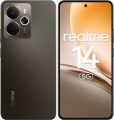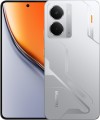DCI-P3
Percentage of the DCI-P3 colour model coverage by a smartphone screen.
This space has a wider range of colours than the standard sRGB "triangle". In general, the DCI-P3 colour space corresponds to the Adobe RGB model, but with a shift to red. In fact, a high coverage rate means high-quality colour reproduction of the screen and allows finer processing of the images received from the camera of a mobile device.
Test results
The test results are specified either by a younger model in a line or a particular model, made for a better understanding performance of phone models if you compare phones against these parameters. For example, the 128 GB model has test results, and the 256 GB model has no information on the network, and in both models you will see the same value that will give an understanding of the overall performance of the device. But if the editorial office has information for each model individually, then each model will have its test results filled out, and the model with bigger RAM will have bigger values.
AnTuTu Benchmark
The result shown by a device when undergoing a performance test (benchmark) in AnTuTu Benchmark.
AnTuTu Benchmark is a comprehensive test designed specifically for mobile devices, primarily smartphones and tablets. It evaluates the efficiency of the processor, memory, graphics, and input/output systems, providing a clear impression of the system's capabilities. The higher the performance, the more points are awarded. Smartphones that score over 1.1M points are considered
high-performance according to the AnTuTu ranking.
Like any benchmark, this test does not provide absolute precision: the same device can show different results, usually with deviations within 5-7%. These deviations depend on various factors unrelated to the system itself, such as the device's load from third-party programs and the ambient temperature during testing. Therefore, significant differences between two models can only be noted when the gap in their scores exceeds this margin of error.
Slow motion (slow-mo)
The frame rate supported by the phone in
slow motion (slow-mo).
In general, such shooting is called "high-speed" because it is carried out at an increased frame rate (more than 60 frames per second). As a result, when playing at normal speed (60 fps and below), the video looks slow (hence the name “slow-mo”). Such slowing down can be used just for fun, and as an artistic tool, and even for scientific purposes — to capture movement that is too fast for human perception. Anyway, the higher the slow-mo frame rate, the more you can slow down the video and the more advanced the camera is in this regard; the minimum value nowadays is actually 120 fps, and in advanced devices this figure is
480 fps and even more(in some models — more than 7000 frames per second). On the other hand, the higher the frame rate, the more performant the GPU should be; and this, in turn, affects the price of the device, sometimes quite noticeably.
Also note that slow-mo shooting can only be available at certain resolutions, which are not always the maximum; these points can be directly specified in the specs of the smartphone.
Image stabilization
—
Optical stabilization. Image stabilization is carried out by a system of moving lenses and gyroscopes, which compensates for small shifts and shaking. Thus, the image formed by the lens hits the sensor already stabilized. The main advantage of such systems over electronic ones is the ability to use the entire area of the sensor, which has a positive effect on the quality of images. On the other hand, optical stabilizers are noticeably more complex and expensive, so they are mainly used in high-end smartphones equipped with top-tier cameras.
—
With sensor shift. Stabilization, carried out by shifting the sensor "following" the shifted image. Like the optical one described above, it is considered a fairly advanced option. Sensor-shift systems have serious advantages - first of all, the stabilization system works regardless of the characteristics of the lens. This means that the lens design can do without an optical stabilizer, which simplifies the design of the camera.
Fast charging
Fast charging technology supported by the device.
By itself,
fast charging, as the name suggests, reduces the charging time compared to the standard procedure. For this, increased voltage and/or current strength is used, as well as a special "smart" process control. But the possibilities and features of such charging may be different, depending on the specific technology used in the device. The same technology must be supported by the charger — this is the only way to guarantee the proper operation. However some types of fast charging are mutually compatible — but this point should be clarified separately, and compatibility is not always complete.
Here is a brief description of the most popular technologies nowadays:
— Quick Charge (1.0, 2.0, 3.0, 4.0, 5.0). Technology created by Qualcomm and used in smartphones with Qualcomm processors. The later the version, the more advanced the technology: for example, Quick Charge 2.0 provides 3 fixed voltage options, and version 3.0 has a smooth adjustment in the range from 3.6 to 20 V. Most often, devices with a newer version of Quick Charge are also compatible with older chargers, but for full use, an exact match in versions is desirable.
Also note that certain versions of Quick Charge have become the basis for some other technologies, such as Asus BoostMaster and Meizu mCharge. However, again, the mutual compatibility of devices supporting these technologies
...needs to be clarified separately.
— Pump Express. Own development of MediaTek, used in smartphones with processors of this brand. Also available in several versions, with improvements and additions as it develops.
— Samsung Charge (Samsung Fast Charge, Adaptive Fast Charging). Samsung's proprietary fast charging technology. It has been used without any changes since 2015, so it looks quite modest against the newer standards. Nevertheless, it is able to provide good speed, especially for the first 50% of the charge.
— Power Delivery (Power Delivery 2.0). "Native" fast charging technology for the USB-C connector; can be used in smartphones of different brands equipped with such a connector. Also note that Power Delivery is supported not only by chargers and power banks, but also by separate USB ports of computers and laptops.
— Asus BoostMaster. Proprietary technology used in Asus smartphones. The specs are similar to Quick Charge 2.0; noticeably inferior to many more modern formats, but generally quite effective.
—Meizu mCharge. Meizu proprietary technology. It is interesting, in particular, because it combines Quick Charge from Qualcomm and Pump Express Plus from MediaTek; compatibility with these technologies needs to be specified separately, however, problems in this regard do not occur so often.
— Huawei PowerUp. One of Huawei's proprietary technologies. Formally similar to Quick Charge 2.0, but used with both Qualcomm and other brands of mobile CPUs, so compatibility is not guaranteed. In general, it is considered obsolete, gradually being replaced by more advanced standards like the SuperCharge Protocol.
— Huawei SuperCharge Protocol. Another proprietary technology from Huawei introduced in 2016; for 2021 is available in several versions. In some devices, the power of such charging exceeds 60 V — not a record, but a very solid indicator.
— Honor SuperCharge. A technology used mainly in advanced Honor smartphones. Until 2020, this brand belonged to Huawei, so Honor SuperCharge is, in fact, the same Huawei SuperCharge Protocol, only with improvements (at least in devices released after 2020).
— OnePlus Dash Charge. A relatively old proprietary standard from OnePlus. An interesting feature is that in some devices the effectiveness of Dash Charge is practically independent of the use of the screen: when the display is on, the battery charges at almost the same rate as when it is off. Technically a licensed version of OPPO's VOOC, however, these technologies are not compatible. Since 2018, Dash Charge has been gradually superseded by Warp Charge.
— OnePlus Warp Charge. OnePlus proprietary standard, released in 2018, including to replace Dash Charge. It is positioned as a technology that can function effectively even with intensive use of the smartphone — in particular, during games.
— Oppo VOOC. OPPO technology, used both in branded smartphones and in equipment from other brands. Available in several versions; The latest (for 2021) version of SuperVOOC is for 2-cell batteries and is sometimes listed as a separate technology called Oppo SuperVOOC Flash Charge.
— Oppo Super Flash Charge (SuperVOOC Flash Charge). Development of Oppo VOOC technology. One of the fastest (for 2021) charging technologies, it allows you to charge a 4000 mAh battery in just over half an hour. Provides for the use of special two-cell batteries.
— Vivo Flash Charge. Proprietary technology from Vivo. It features high power and speed: the process of charging a 4000 mAh battery takes only 13 minutes.
— Realme Dart Charge. Proprietary Realme brand technology. It has average, by modern standards, indicators of power and speed.
— Motorola Turbo Power. Motorola proprietary technology, found in almost all modern smartphones and tablets of this brand, as well as in separate devices from Lenovo. Available in several versions. It 's not super fast, but in general it has quite decent specs; in addition, devices with Turbo Power are also fully compatible with chargers that support Quick Charge (version 2.0 and higher).
